8 Dried Flower Top Tips
- Handle dried flowers with care
- Take time to prepare the stems before use
- Choose the right vase or vessel
- Mix it up! Blend with preserved and faux blooms
- Protect from extremes of temperature, dampness and harsh sunlight
- Store with care in the right containers, and environment
- Choose dried for important venues and events for sustainability, longevity, and economy
- Re-use and re-purpose - Think sustainability
Handle With Care
It's important to remember that although dried flowers are often referred to as everlasting or forever blooms due to their longevity, they are extremely delicate. To get the best from your florals, treat them with gentle hands, from the moment you unpack them until the last stem is put into place.
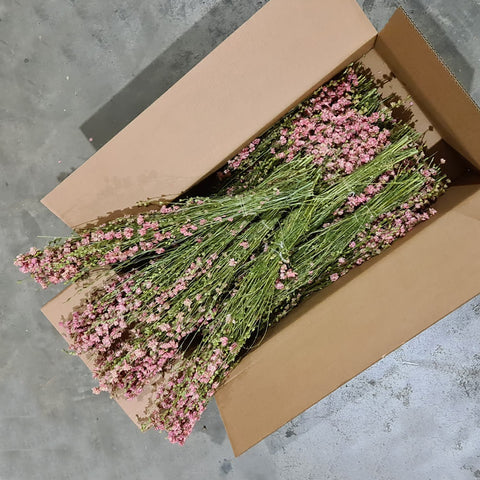
Separate Stems Gently To Reduce Wastage
Dried flowers are generally sold in bunches of one type of product, so when you start work, carefully separate the stems out from the main bunch taking care not to damage them. Where there are mixed products in a bunch, such as a ready-made bouquet, it can sometimes be quite difficult to split them up. Take it slowly and you will minimise damage. It may be necessary to snip them free on occasion. It's better to have a shorter stem than one that is too damaged to work with!
Preparing The Stems
Depending on your project, you will need to prepare the stems to suit. This may involve taking off leaves or thorns or trimming down the length. It's worth investing in a good set of basic tools to make your life easier. You may find some stems require a little help to stand tall, and this is where a fine wire will come in handy. Some stems need wire wrapped around them, others inserted within. This will also allow for a degree of manipulation but don't overdo it or the product will break.
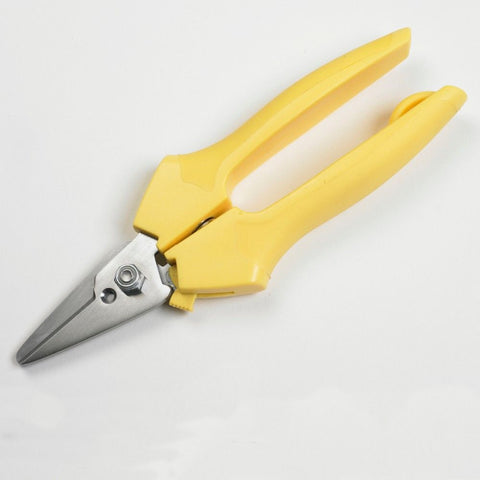
Choosing A Vase or Vessel
If your design is to be displayed in a vase or vessel, there are some things worth considering. Naturally, the height, colour and shape are a matter of personal taste and can be adjusted to suit your flowers. As there's no water involved with dried flowers, you don't have to limit yourself to watertight vessels. Almost any container can become a dried flower vase!
Fixing The Stems Into Place
For sturdy stems, try using dry floral foam, you can ensure your flowers stand in the right place, and look just how you want. Should you have a bunch that doesn't quite fill a large-necked vase, using this method to space out the stems, it will be possible to give the impression that the vase is full. Pot tape is useful in a similar way and is very helpful when dealing with stems that aren't strong enough to be inserted into foam blocks. By applying the tape in crisscrosses over the surface of the pot, you create a mesh into which you can insert your stems.
Mix It Up!
When working with dried florals, there's no need to limit yourself to an entirely dried project. It is possible to blend dried flowers with preserved and faux blooms to create a stunning effect.
Preserved Florals
These blooms look and feel fresh, and can be mixed into a dried display easily. Simply put, the moisture in a fresh bloom is replaced with a natural glycerine and vegetable dye solution. This mix of preservative and colour keeps the product looking fab, as just glycerine would leave the flower looking dull and various shades of brown!
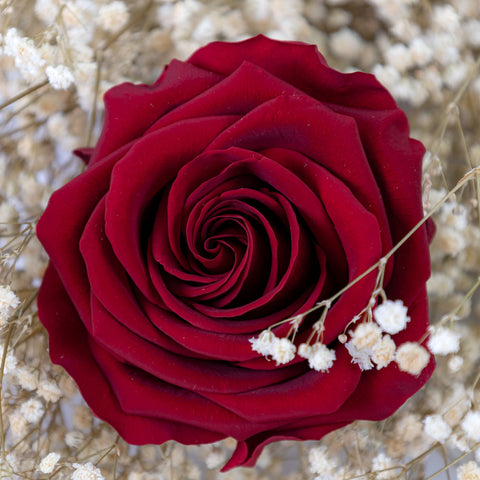
Faux Florals
Artificial stems can be added to just add fill, or as part of the main spectacle. At Atlas, we supply different grades of faux that work with a variety of budgets, so there's bound to be something in there for you! Both preserved and faux products will last just as long as your dried flowers if you care for them well. Just like the dried stems, preserved do not have moisture, extreme heat or too much sunlight. Many faux products are UV-safe, meaning they will put up with quite a lot of sunlight, so you can always use these front and centre to help save your other products.
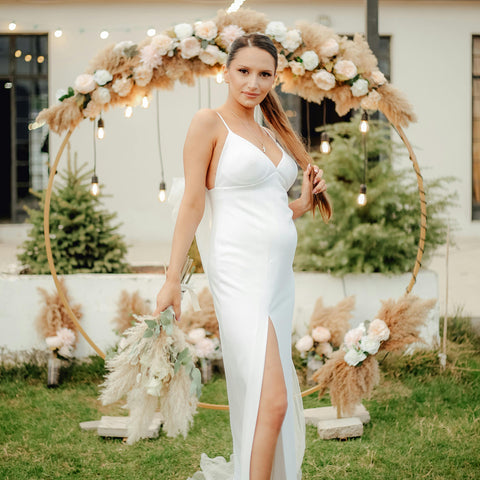
The image above shows a circular wedding backdrop that has been created using fluffy, natural pampas grass and artificial flowers. Pampas is a fairly robust product that copes quite well with outdoor installations. Combining it with faux products gives the finished piece more resilience than fresh blooms when weather conditions are uncertain.
No Water
Remember, there's no water required for dried flowers - water and dampness are the enemy. To prevent damage, mould and disintegration, it's essential to keep the products as dry as possible, so avoid placing them in a busy kitchen or steamy bathroom. This said harsh heat and sunlight are also bad for keeping dried flowers in good condition, so avoid placing them near radiators, open fires, or in full sun. Displays in vases, tables and sideboards are ideal, and if you are hanging an indoor wreath, avoid placing it above a hot radiator. Not having to soak foam or fill vases with water and then maintain them to keep the flowers fresh, saves time and reduces mess.
Storage
One of the great things about working with dried flowers is their longevity. When cared for correctly, they will still look their best for many months, even years. Purchasing or preparing flowers ahead of a deadline without the worry that they will deteriorate means less stress and worry. You can buy your products months in advance, create your work, and store it until it's needed. It's essential to store these items carefully, so take a look at our dried flower storage guide for more info.
Installations and Large Displays
Large installations or displays are where dried flowers can come into their own. All flowers are expensive, so getting as much out of them as possible makes a lot of sense. A big, fresh flower installation could cost hundreds, if not thousands, of pounds, but may only last a few days before it starts to deteriorate, losing visual impact. With a dried flower installation, it can be months before any loss of quality can be detected, and it may be well over a year before you need to remove it.
Similarly, for weddings and celebrations where the display is more temporary, there's the option to repurpose, sell, or keep parts of the creation. This is a more economical and less wasteful way to make a special day beautiful. Weddings in particular can be a stressful and expensive time, so being able to plan and purchase your flowers well ahead of time, and possibly recoup some of the money after the event is a win-win!
Reuse and Repurpose
Another fantastic thing about dried flowers is that they can be reused and repurposed. As mentioned above, after a wedding or celebration, flower installations and displays can be dismantled and reused, or sold to help budget-conscious wedding planners keep their costs down.
A wedding florist could take parts of the original installation to create favours for guests, and the wedding couple could then send them on as thank-you gifts. Such keepsakes are a lovely way to keep the day alive in your guest's memories.
Flowers in the home can be reworked from a vase display into a wreath or garland, or even used to make flower-embellished candles, coasters or framed wall art. We looked at creative side hustles that use dried flowers, which may give you some ideas.
Improve Sustainability
The fact you can reuse dried flowers again and again means they are by far a better option if sustainability and the environment are important to you. Many people don't realise the number of resources required to grow and ship fresh flowers around the world. That cheap(ish) bouquet that is for sale at the petrol station down the road may well have begun its journey in Africa, South America, or China.
Reducing Environmental Impact
In some cases, swathes of land are taken up for flower production, in giant glasshouses, draining the area of precious water. This can have serious effects on local the community's ability to farm and maintain sufficient water supplies in already drought-prone areas. These flowers are then harvested when immature and shipped worldwide using chilled road and air freight so they stay fresh, and can be packed in their destination countries. Bouquets then may last a week or so before they end up in a bin, along with their harmful plastic wrapping.
This interesting TED ideas piece has some insight into this issue.
Fewer Flower Miles
Dried flowers that Atlas Flowers stock are predominantly from the Netherlands, and others from a few other nearby European countries, where they are grown out in the open, seasonally, and without the use of harmful chemicals. The production process is almost entirely manual, from sowing to harvest to packing, meaning that there is a minimal carbon footprint left by mechanical devices. The energy within the cutting-edge plant of our main suppliers is obtained through renewable means and water used on site is recycled wherever possible.
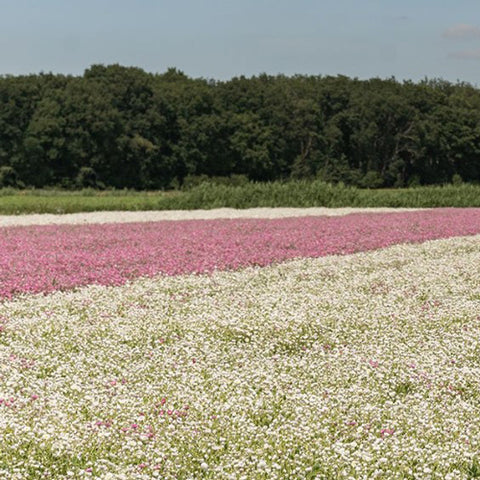
Once the blooms are harvested, by hand, they are then left to dry naturally. Recycled cardboard boxes are used to pack the blooms before they are transported to the UK by lorry. While we understand that there is still a carbon footprint, it is hugely reduced by the systems in place, and we and our suppliers are always looking to improve.
UK Grown
We are often asked about British flowers, and we are proud to have a small range available. The weather is always an issue here, and these producers do very well with the conditions that they have to deal with throughout the UK growing season to generate a proportion of our stock. Again, these products are grown naturally, outside, and this limits the production levels but does make them far more sustainable than glasshouse flowers grown all year round.
Fair Trade
The small selection of dried exotics we have on offer are from Fair Trade growers, and this certificated system makes use of naturally occurring, seasonal products, rather than intensive farming methods. These items are also prepared manually and dried naturally, and although they are delivered to us via airfreight due to their location, they make up a tiny proportion of our stock.
Ultimately, by choosing a dried flower over a fresh one, you will be opting for a more ethical product, which will last and last, so potentially saving you money and helping the environment.
